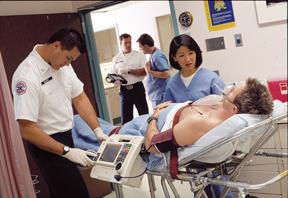
Physio-Control LifeNet System Adds Stroke Alert Capability to Speed Patient Time-to-Treatment
March 12, 2013 – With the recent release of the updated American Heart Association (AHA)/American Stroke Association (ASA) Guidelines for Early Management of Acute Stroke Patients, Physio-Control announced that the LifeNet System’s OnePush feature can be used to rapidly activate stroke care teams. LifeNet’s stroke alert capability enables faster time-to-treatment, assisting stroke care teams in meeting the updated AHA/ASA Guidelines and helping improve stroke patient outcomes. The updated guidelines, released Jan. 31, 2013, support the overarching concept of stroke systems of care and detail aspects of stroke care from patient recognition; emergency medical services activation, transport and triage; through the initial hours in the emergency department and stroke unit.[1]
The LifeNet stroke alert capability utilizes LifeNet’s easy-to-configure settings allowing hospitals to create a OnePush automated stroke protocol activation, similar to how customers now activate a STEMI alert protocol. When a prehospital notification of a stroke is received, the appropriate notifications, vital signs and ECGs are forwarded to the entire hospital stroke team and events are recorded, noting the time of the protocol activation which aids in documenting response times for quality improvement purposes. In addition, a OnePush stroke alert can be activated by hospital personnel in the event a stroke patient self-transports to a hospital. Fundamental events associated with stroke management that can be activated by hospitals and documented with LifeNet include:
- Activation of stroke team
- Computed tomography (CT) or magnetic resonance imaging (MRI) scan initiation
- CT or MRI interpretation
- Admission of recombinant tissue plasminogen activator (rtPA) therapy
- Stroke unit admission notification
In addition to STEMI and stroke alerts, LifeNet can be easily configured to help facilitate a wide range of protocol-driven treatments requiring timely intervention and documentation, such as therapeutic hypothermia or pediatric trauma.
“The LifeNet System has proven to be a critical tool in enabling STEMI systems of care, helping care teams meet or exceed the AHA recommended door-to-balloon time of under 90 minutes,” said Brian Webster, president and CEO, Physio-Control. “We expect the new stroke team activation capability of LifeNet to do for stroke systems what it has already done for STEMI systems. With LifeNet’s easy-to-configure alerts, stroke care teams can streamline their protocol activation and documentation to help improve stroke patient outcomes and meet their quality improvement initiatives.”
For more information: www.physio-control.com
1 Jauch, Saver, et al. Guidelines for the Early Management of Patients With Acute Ischemic Stroke, American Heart Association/American Stroke Association. Stroke. 2013;44:870-947. http://stroke.ahajournals.org/content/44/3/870


 May 04, 2020
May 04, 2020 

